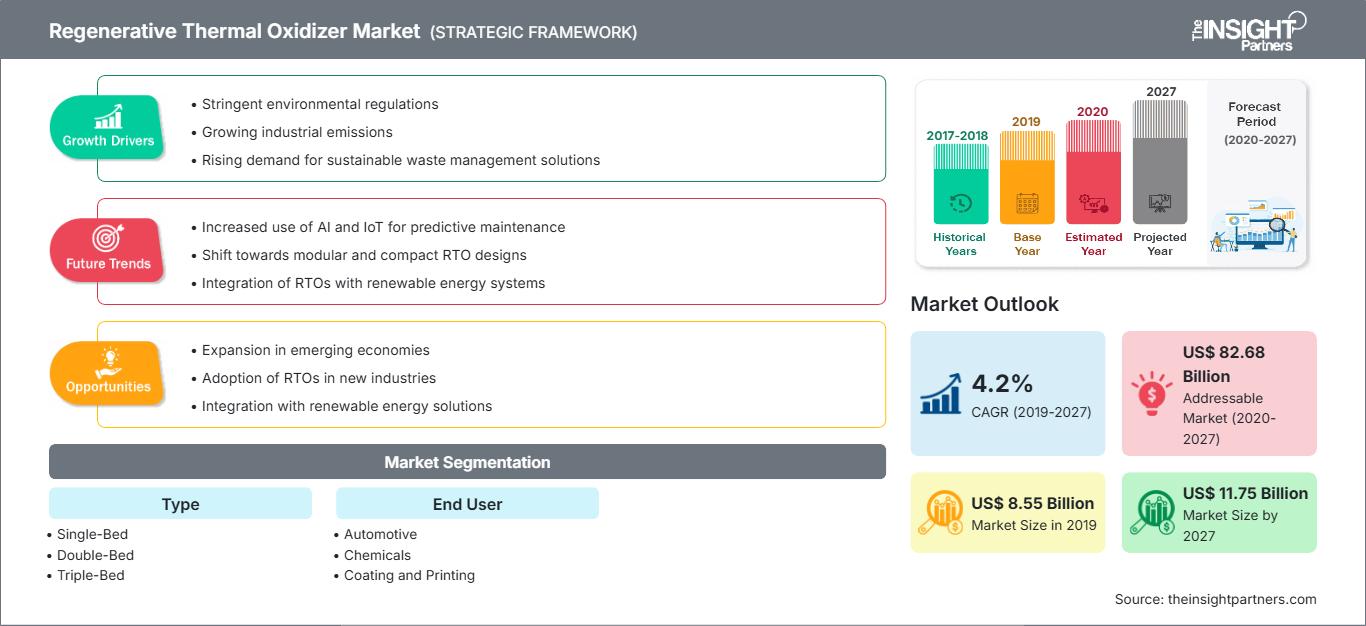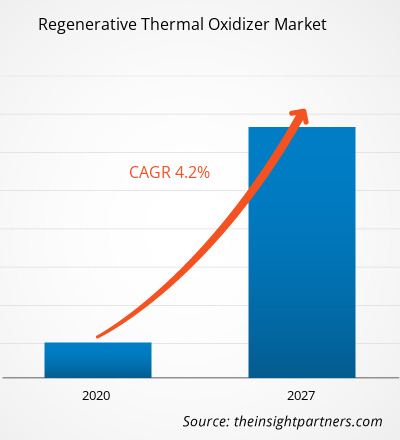Der Markt für regenerative thermische Oxidationsmittel (RTO) wurde 2019 auf 8,55 Milliarden USD geschätzt und soll bis 2027 11,75 Milliarden USD erreichen; von 2020 bis 2027 wird ein CAGR-Wachstum von 4,2 % erwartet.
Technologien zur Luftreinhaltung bieten in verschiedenen Branchen umfassende Anwendungsgebiete zur Reduzierung schädlicher Schadstoffe in der Atmosphäre. Derzeit erfreuen sich zahlreiche Chemikalien, thermische und elektrostatische Abscheider und Wäscher sowie weitere Geschäftsangebote in den Endverbraucherbranchen großer Beliebtheit; diese Produkte werden üblicherweise von mehreren Akteuren auf dem Markt für regenerative thermische Oxidationsmittel (RTO) angeboten. Trotz der hohen Kosten industrieller RTOs haben diese in den letzten Jahren eine breite Akzeptanz gefunden. Faktoren wie die Existenz strenger gesetzlicher Richtlinien und ein steigendes Bewusstsein für Umweltverschmutzung und Arbeitssicherheit sind die Hauptfaktoren, die das Wachstum des Marktes in den letzten Jahren vorantreiben.
Derzeit umfasst der globale Markt für regenerative thermische Oxidationsmittel (RTO) eine beträchtliche Anzahl von Marktteilnehmern mit regionalem Fokus und vielfältigen Geschäftsangeboten. Der Markt umfasst jedoch auch eine bemerkenswerte Anzahl weltweit führender Akteure wie Alliance Corporation, Anguil Environmental Systems, Inc., Catalytic Products International, Condorchem Envitech, Eisenmann SE, Filtracní Technika, Spol. sr.o., Shandong Baolan Environmental Protection Engineering Co., Ltd., Ship & Shore Environmental, Inc., Taikisha Ltd. und The CMM Group LLC. Darüber hinaus bieten die Akteure dieses Marktes eine breite Palette maßgeschneiderter, flexibler und robuster Lösungen für regenerative thermische Oxidationsmittel (RTO) für verschiedene Endverbraucherbranchen.
Das verarbeitende Gewerbe gehört zu den Schlüsselsektoren, die jedes Jahr einen erheblichen Anteil zur Luftverschmutzung beitragen. Angesichts der zunehmenden Besorgnis über die Umweltzerstörung und den Abbau der Ozonschicht durch giftige Substanzen (HAPs und VOCs) sowie Industriegase konzentrieren sich Hersteller verstärkt auf den Einsatz fortschrittlicher Technologien zur Vernichtung giftiger Substanzen und zur Reduzierung schädlicher Emissionen. Dies führt zu einer erheblichen Nachfrage nach RTOs bei den Herstellern.
Passen Sie diesen Bericht Ihren Anforderungen an
Sie erhalten kostenlos Anpassungen an jedem Bericht, einschließlich Teilen dieses Berichts oder einer Analyse auf Länderebene, eines Excel-Datenpakets sowie tolle Angebote und Rabatte für Start-ups und Universitäten.
Markt für regenerative thermische Oxidationsmittel: Strategische Einblicke

- Holen Sie sich die wichtigsten Markttrends aus diesem Bericht.Dieses KOSTENLOSE Beispiel umfasst Datenanalysen, die von Markttrends bis hin zu Schätzungen und Prognosen reichen.
Auswirkungen der COVID-19-Pandemie auf den Markt für regenerative thermische Oxidationsmittel
Sie erhalten kostenlos Anpassungen an jedem Bericht, einschließlich Teilen dieses Berichts oder einer Analyse auf Länderebene, eines Excel-Datenpakets sowie tolle Angebote und Rabatte für Start-ups und Universitäten.
Markt für regenerative thermische Oxidationsmittel: Strategische Einblicke

- Holen Sie sich die wichtigsten Markttrends aus diesem Bericht.Dieses KOSTENLOSE Beispiel umfasst Datenanalysen, die von Markttrends bis hin zu Schätzungen und Prognosen reichen.
Die anhaltende COVID-19-Pandemie führt weiterhin zu langfristigen Störungen in mehreren wichtigen Prozess- und Fertigungsindustrien, darunter Automobil, Chemie, allgemeine Fertigung, Elektro- und Elektronikindustrie sowie Pharmazie. Kritische Branchen wie die Lebensmittel- und Getränkeindustrie, Pharmazie, Stromerzeugung und Chemie verzeichneten während der Pandemie jedoch in verschiedenen Volkswirtschaften aufgrund ihrer Bedeutung für die Versorgung und Grundversorgung nur begrenzte Störungen. Infolgedessen hat der landesweite Lockdown zur Minimierung der Virusübertragung die Lieferkettenaktivitäten und die Produktion von Komponenten, Geräten, Steuerungen und Rohstoffen für regenerative thermische Oxidationsmittel (RTO) bei mehreren Herstellern, insbesondere bei kleinen und mittleren Unternehmen, erheblich gestört. Darüber hinaus wird erwartet, dass die eingeschränkten Produktionsaktivitäten zusammen mit der schwindenden Nachfrage der Endverbraucherindustrien den Gesamtmarktumsatz im Jahr 2020 senken und in den nächsten Jahren zu einem Rückgang des Marktwachstums führen werden.
Markteinblicke: Anstieg der Emissionsmenge giftiger Substanzen
Der globale Industriesektor erlebt seit dem letzten Jahrzehnt ein erhebliches Wachstum. Die Industrialisierung in den entwickelten Ländern Nordamerikas und Europas ist hauptsächlich auf die starken Volkswirtschaften und die staatliche Unterstützung zurückzuführen. Der Fertigungssektor trägt einen erheblichen Anteil zum BIP des jeweiligen Landes bei, weshalb die Regierungen der entwickelten Länder großen Wert auf die Entwicklung des Fertigungssektors in ihren jeweiligen Ländern legen. Die Produktionseinheiten von Branchen wie Automobil, Chemie, Pharmazie, Petrochemie, Wärmekraftwerke, Kernkraftwerke, Luft- und Raumfahrt sowie Beschichtung und Druck stoßen enorme Mengen an HAPs und VOCs aus den Abgasen aus, was zu schwerer Umweltverschmutzung führt. Um die Emission von HAPs und VOCs zu zerstören und zu unterdrücken, bieten verschiedene Entwickler von Industrietechnologien und -systemen RTOs für verschiedene Industrieanlagen an.
Typbasierte Markteinblicke
Basierend auf dem Typ ist der globale Markt für regenerative thermische Oxidationsmittel in Einbett-, Doppelbett- und Dreibett-Regenerative thermische Oxidationsmittel unterteilt. Unternehmen wie die Dürr Group bieten den DürrMegtecVocsidizer an, einen Einbett- und flammenlosen regenerativen thermischen Oxidationsmittel (RTO) mit modularem Design. Er gewährleistet niedrige Betriebskosten für die VOC-Minderung und HAP-Kontrolle. Das System gewährleistet eine hohe VOC-Zerstörung bei gleichzeitiger Zuverlässigkeit, einfachem Design und höchster Energieeffizienz. Die Doppelbett-RTOs sind die am stärksten nachgefragten regenerativen thermischen Oxidationsmittel. Wenn diese Konstruktionen in Verbindung mit einem gut konzipierten Tellerventil verwendet werden, wird ein Zweikammer-Keramikmedienbett-Designsystem effizienter und kompakter. Zusätzlich zu der besonderen Konstruktion benötigen diese RTOs weniger Material und sind weniger teuer in der Herstellung.
Markteinblicke auf Endverbraucherbasis
Basierend auf dem Endverbraucher ist der Markt für regenerative thermische Oxidationsmittel in die Branchen Automobil, Chemie, Beschichtung und Druck, Pharma, Lebensmittel und Getränke, Halbleiter und andere unterteilt. Die Kontrolle der Luftverschmutzung ist aufgrund der zunehmend strengeren Emissionsvorschriften ein allgemeines Anliegen in der chemischen Fertigungsindustrie. Daher gewinnt der Bedarf an fortschrittlichen Lösungen zur biologischen, thermischen und chemischen Abfallbehandlung stark an Bedeutung. Bei der Herstellung von Chemikalien entstehen verschiedene ätzende und giftige anorganische Stoffe, die vor der Oxidation gewaschen werden müssen. Daher steigt die Nachfrage nach Wäschern und Oxidationsmitteln in der chemischen Industrie zur Behandlung chemischer Gasemissionen und ätzender Stoffe stark an. Dies fördert das Wachstum des Marktes für regenerative thermische Oxidationsmittel in der chemischen Industrie.
initiativen sind die von Unternehmen häufig verfolgten Strategien zur Erweiterung ihres Produktportfolios. CPI ist einer der Hauptakteure, die diese Strategien umsetzen, um den Kundenstamm zu vergrößern und einen signifikanten Anteil am Markt für regenerative thermische Oxidationsmittel zu gewinnen, was dem Unternehmen wiederum ermöglicht, seinen Markennamen auf dem globalen Markt für regenerative thermische Oxidationsmittel zu behaupten.
2020: CPI installierte einen regenerativen thermischen Oxidator (RTO) Triton-II-2.95 mit 2.000 SCFM, um die VOC-Emissionen aus sechs Tankentlüftungen in einer Anlage zu kontrollieren. Darüber hinaus installierte das Unternehmen auch einen dualen Nebelabscheider, um die Emissionen anorganischer Partikel im Submikronbereich aus einem Tankentlüftungsprozess zu regulieren, bevor diese zum RTO gelangen.
2019: CPI installierte einen regenerativen thermischen Oxidator (RTO) mit +99 % DRE im Web Coater im Nordosten der USA zur Zerstörung von VOCs und HAPs. Der 60.000 SCFM Triton II-60.97 regenerative thermische Oxidationsapparat (RTO) wird die HAP- und VOC-Emissionen von drei Bahnbeschichtungslinien und den dazugehörigen Öfen in der Anlage regulieren.
2016: Führende petrochemische Unternehmen in China forderten eine Reduzierung der VOC-Emissionen aus der Anlage zur Herstellung von gereinigter Terephthalsäure (PTA). Methylacetat, Xylol, Benzol, Methylbromid, Methanol und CO waren einige der Emissionen, die durch den Herstellungsprozess in der Anlage verursacht wurden. Das Unternehmen installierte einen 22.500 SCFM 3-Kanister regenerativen thermischen Oxidationsapparat (RTO) mit 99 % VOC-Zerstörung und 95 % thermischer Energierückgewinnung (TER).
Markt für regenerative thermische Oxidationsmittel
Die Analysten von The Insight Partners haben die regionalen Trends und Faktoren, die den Markt für regenerative thermische Oxidationsmittel im Prognosezeitraum beeinflussen, ausführlich erläutert. In diesem Abschnitt werden auch die Marktsegmente und die geografische Lage für regenerative thermische Oxidationsmittel in Nordamerika, Europa, im asiatisch-pazifischen Raum, im Nahen Osten und Afrika sowie in Süd- und Mittelamerika erläutert.Umfang des Marktberichts über regenerative thermische Oxidationsmittel
| Berichtsattribut | Einzelheiten |
|---|---|
| Marktgröße in 2019 | US$ 8.55 Billion |
| Marktgröße nach 2027 | US$ 11.75 Billion |
| Globale CAGR (2019 - 2027) | 4.2% |
| Historische Daten | 2017-2018 |
| Prognosezeitraum | 2020-2027 |
| Abgedeckte Segmente |
By Typ
|
| Abgedeckte Regionen und Länder | Nordamerika
|
| Marktführer und wichtige Unternehmensprofile |
|
Marktdichte der Akteure im Bereich regenerativer thermischer Oxidationsmittel: Verständnis ihrer Auswirkungen auf die Geschäftsdynamik
Der Markt für regenerative thermische Oxidationsmittel wächst rasant. Dies ist auf die steigende Endverbrauchernachfrage zurückzuführen, die auf Faktoren wie veränderte Verbraucherpräferenzen, technologische Fortschritte und ein stärkeres Bewusstsein für die Produktvorteile zurückzuführen ist. Mit der steigenden Nachfrage erweitern Unternehmen ihr Angebot, entwickeln Innovationen, um den Verbraucherbedürfnissen gerecht zu werden, und nutzen neue Trends, was das Marktwachstum weiter ankurbelt.
- Holen Sie sich die Markt für regenerative thermische Oxidationsmittel Übersicht der wichtigsten Akteure
- Einzelbett
- Doppelbett
- Dreibett
Nach Endbenutzer
- Automobil
- Chemie
- Beschichtung und Druck
- Pharmazeutika
- Halbleiter
- Sonstige
Nach Geografie
Nordamerika
- USA
- Kanada
- Mexiko
Europa
- Großbritannien
- Deutschland
- Frankreich
- Italien
- Russland
- Restliches Europa
Asien-Pazifik (APAC)
- China
- Japan
- Indien
- Australien
- Südkorea
- Rest von APAC
Naher Osten und Afrika (MEA)
- Saudi-Arabien
- VAE
- Südafrika
- Rest von MEA
Südamerika (SAM)
- Brasilien
- Argentinien
- Rest von SAM
Firmenprofile
- Alliance Corporation
- Anguil Environmental Science
- Catalytic Products International
- CondorchemEnvitech
- Eisemann SE
- Filtračnítechnikaspol. s ro
- Ship and Shore Environmental, Inc.
- Shandong Baolan Environmental Protection Engineering Co., Ltd
- THE CMM GROUP, LLC
- Taikisha Ltd
- Historische Analyse (2 Jahre), Basisjahr, Prognose (7 Jahre) mit CAGR
- PEST- und SWOT-Analyse
- Marktgröße Wert/Volumen – Global, Regional, Land
- Branchen- und Wettbewerbslandschaft
- Excel-Datensatz
Aktuelle Berichte
Erfahrungsberichte
Grund zum Kauf
- Fundierte Entscheidungsfindung
- Marktdynamik verstehen
- Wettbewerbsanalyse
- Kundeneinblicke
- Marktprognosen
- Risikominimierung
- Strategische Planung
- Investitionsbegründung
- Identifizierung neuer Märkte
- Verbesserung von Marketingstrategien
- Steigerung der Betriebseffizienz
- Anpassung an regulatorische Trends




















 Kostenlose Probe anfordern für - Markt für regenerative thermische Oxidationsmittel
Kostenlose Probe anfordern für - Markt für regenerative thermische Oxidationsmittel